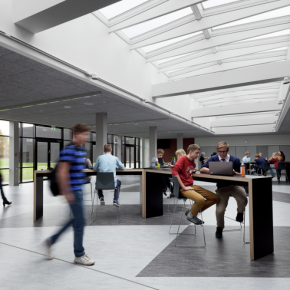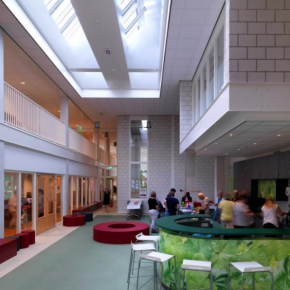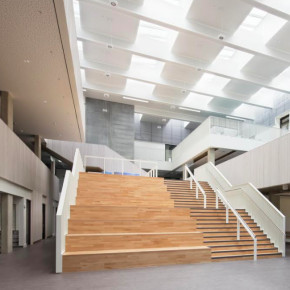
Are we still in the dark when it comes to daylight design? – A VELUX article
This article from VELUX looks at how multiple studies have shown exposure to natural light aids health and wellbeing, increases productivity, improves mood, and even helps to save energy and retain staff.
These studies have also highlighted a need for a greater focus on daylight design, introducing it earlier in the planning process and more comprehensive government lighting standards.
Andrew Bissell, Lighting Director at Cundall, believes daylight design should be involved from the very outset of any project, saying every detail, from where a building site is located, its orientation and the daylight exposure it receives, to window placement, the balance of thermal heating and the use of glazing can influence building comfort, should be considered.
Natural light is an essential design element
Laura Phillips, Lighting Designer and Associate Director at Arup, commented: “Daylight design needs to be involved at the planning stage – any later and its effect is already limited.
“It’s about how light enters a space – thinking about all the rooms, not just basing it on digital models and numbers but also lighting patterns and ensuring light is distributed evenly in every space.
“In my experience, many architects tend to, understandably, base their knowledge of daylight on past projects.
“There is a tendancy to shy away from specifying daylight systems, as they can be costly to a project if not considered and integrated early on, and the benefits can be difficult to sell to a client.
“Greater collaboration on daylight quality is needed – early on within the brief – to create buildings that allow daylight to be utilised to its full potential.”
Daylight is a commodity
Daylight, when harnessed correctly, has been shown to have massive energy benefits, offsetting the need for less healthy artificial lighting while cutting energy costs by 30% to 45%.
Decades of research has also shown exposure to daylight throughout the working day can improve mental function – including memory and speed of work – between 10 and 25%, and improve productivity by up to 15%. It has an even greater psychological effect than fresh air.
Greater access to daylight, and something as simple as having a desk with a view, can also help with staff retention as employees are shown to be happier and take less sick days.
Unfortunately, the adverse of inadequate lighting can have equally extraordinary results as the Chinese government has discovered cases of myopia among China’s schoolchildren increased by over 50% in just 6 years.
The artificial versus natural light debate
A lot of new lighting technology has been designed to replicate natural light, but it offers no real benefit. As much as LED and other artificial lighting claims to mimic natural light, it has a very limited spectrum and lacks the naturally occurring colours vital for proper visual performance, and the regulation of hormones and neurotransmitters in the brain – such as cortisol, which is related to stress, and melatonin, a prerequisite to sleep.
That being said, adequate levels of daylight throughout the day are not always possible due to the ever-changing position of the sun, window orientation and other factors.
Laura Phillips continued: “We work closely with architects and clients to ensure lighting is considered as a whole, both natural and artificial, through detailing and effective lighting controls.”
Layouts need to be designed to balance artificial and natural light, taking into consideration façade reflection, the sun’s movement, glare, shading, light intensity and automation – to ensure spaces are evenly lit, there is good patternation, and external and internal elements work together.
Most importantly, lighting needs to suit the function and needs of the occupants of the space. Offices, laboratories, leisure centres and especially schools all have different, specific requirements.
A new standard for daylight
There is growing demand for more detailed daylight standards and clearer parameters to be introduced to ensure daylight design is implemented at the planning stage.
Whilst recent years have seen a positive step change with the move from daylight factors to climate-based daylight modelling. There is now a need for further changes, such as introducing the spectrum of the light to the matrix as well as more measurement positions relating to the eye position and viewing direction of occupants.
Andrew Bissell added: “We need to move away from current light measuring tools as they just look at the amount of light and not how it affects occupants.
“Measures like melanopic lux and circadian stimulus – which seeks to measure both the visual and biological influences of light – and greater clarity on what ‘health lighting’ means need to be made regulatory standards.”
The more we learn about daylight, the more we see the need for professional bodies to influence government to improve standards. More case studies and research is also needed to develop best practices.
Event series like VELUX’s DESIGN A BRIGHTER FUTURE are a definite step in the right direction as a way to highlight the need for more integrated daylight strategies.
Laura Phillips will be speaking at the event in Glasgow this November, and Andrew Bissell recently spoke at the event in Manchester.
“It is bringing together developers, architects, lighting designers and academics into one room to discuss research and real evidence of how to better utilise daylight and ventilation to build healthier buildings. This is what we need and it can really make a big difference,” Andrew said.
Daylight design is still considered a “non-discipline” and the responsibility of it sits across the design team. Focusing more on the importance of daylight in the built environment is key, it could be taught to a much greater extent at university level.
When lighting specialists are appointed to design daylight schemes for galleries and museums, some staggering results are achieved in the process of ensuring works of art are not damaged by lighting.
Yet the same level of service is not afforded many regular buildings we use, is our health and wellbeing less important than preserving art?
To find out more about how daylight and ventilation improves human well-being and performance, book your free place at the next Velux: Design a Brighter Future Breakfast Event.
Upcoming events are London (19 Sep), Birmingham (23 Oct) and Glasgow (7 Nov).
For more details and to register, visit Eventbrite.co.uk and search for “VELUX”.
Contact:
Velux Co Ltd
Woodside Way
Glenrothes East
Fife
KY7 4ND
Phone: 01592 778927
Fax: 01592 771839
Visit Supplier's page
Latest news

22nd November 2024
Pop Up Power Supplies Gets Arty in Yorkshire
Pop Up Power Supplies has installed 13 new electricity units at The Hepworth Wakefield – read more in this article…
Posted in Articles, Building Industry News, Building Products & Structures, Building Services, Case Studies, Civil Engineering, Facility Management & Building Services, Garden, Hard Landscaping & Walkways, Landscaping, Posts, Restoration & Refurbishment, Retrofit & Renovation
22nd November 2024
OPT Services Revolutionises Fibre Cable Capping with Eco-Friendly Innovation
UK-based OPT Services has unveiled SlimLine™ Capping, a groundbreaking fibre cable protection solution that promises to deliver significant environmental and installation advantages to the fibre optic industry.
Posted in Articles, Building Industry News, Building Products & Structures, Building Services, Facility Management & Building Services, Information Technology, Innovations & New Products, Sustainability & Energy Efficiency
22nd November 2024
CRL: The elegance of Paris balconies - a modern touch for any home
Paris balconies, with their timeless charm and practicality, are becoming something of an architectural staple in urban and rural environments, as CRL explains here…
Posted in Articles, Balustrades and Guardrails, Building Industry News, Building Products & Structures, Case Studies, Garden, Glass, Glass Projects, Restoration & Refurbishment, Retrofit & Renovation
21st November 2024
Altro distils style and performance at English Spirit
English Spirit Distillery has used an extensive package of Altro products front and back of house, in their new visitor centre café, shop and viewing area for the working distillery.
Posted in Articles, Bathrooms, Bedrooms & Washrooms, Building Industry News, Building Products & Structures, Building Systems, Case Studies, Floors, Interior Design & Construction, Interiors, Kitchens, Restoration & Refurbishment, Retrofit & Renovation, Timber Buildings and Timber Products, Walls
 Sign up:
Sign up: 

